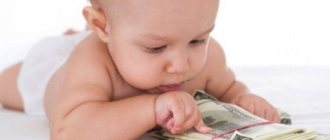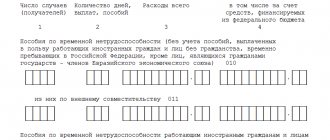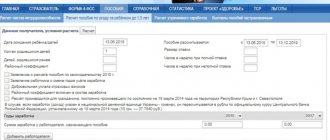In 2021, citizens receive the same payments as in 2021, but in an increased amount (meaning those state benefits for which the law provides for annual indexation). The exception is maternity capital, the amount of which has not increased since 2015. In 2021, a certificate for the second child (or subsequent) is also provided in the amount of 453,026 rubles . No decisions have yet been made on new social support measures for families with children .
State child benefits were indexed on February 1, 2021 by 4.3% . As for the minimum and maximum values of payments provided from the FSS (Social Insurance Fund), they have already been increased on January 1 , these include benefits such as:
- “maternity” benefit for pregnancy and childbirth (BiR);
- monthly child care benefits until he turns 1.5 years old.
For several years now, the issues of increasing payments for child care under 3 years of age have been discussed (currently they are provided to workers every month in the amount of 50 rubles), as well as compensation for earnings when caring for a disabled child (not increased since 2013), but today none of the proposed initiatives has yet been adopted .
On February 20, 2021, Vladimir Putin addressed the Federal Assembly , during which he proposed a package of new measures to support families with children, namely:
- From July 1, 2021, increase the amount of monthly benefits for the care of disabled children from 5.5 thousand rubles to 10 thousand rubles .
- From January 1, 2021, simplify the conditions for applying for benefits that are provided upon the birth of the first or second child from January 1, 2021 (Putin’s benefit). per capita income is not higher than one and a half times the subsistence level for the working population can receive payments to two subsistence levels .
- When a third child is born in a family, you must “repay” directly from the federal budget 450 thousand rubles from the mortgage loan of such a family (if you add this amount with maternity capital, you get more than 900 thousand rubles , which can be used to repay the mortgage loan). The President proposed to launch this support measure retroactively - from January 1, 2019 .
Photo pixabay.com
Indexation of child benefits in 2021
In recent years, the indexation of social payments, including child benefits, has been carried out on February 1, according to Decree of the Government of the Russian Federation dated January 28, 2018 No. 42.
If before January 1, 2021, increases in benefits, compensation and other payments were carried out ahead of expected inflation, now payments are indexed based on actual inflation over the past year. In 2021, benefits are indexed from February 1.
In the government decree of January 24, 2021, the indexation coefficient for child benefits from February 1 is 1.043.
On February 1, 2021, the following benefits were indexed:
- One-time benefit for women registered before 12 weeks of pregnancy;
- One-time payments in connection with the birth of a child.
The child care benefit for children under 1.5 years of age increased from January 1, due to the fact that from January 1, 2021, the minimum wage (minimum wage) is equal to the subsistence level for the second quarter of 2021.
Child care allowance up to 3 years old
A monthly compensation payment for up to 3 years is paid to one of the parents caring for the child. The amount of this benefit was established back in 1994 by Presidential Decree No. 1110 in the amount of 50 rubles.
The last time the issue of increasing this payment was discussed was in 2014, but in the end no decision was made.
The benefit amount will change from 2021
In 2021, there is finally talk of increasing benefits at a “high level.” The information that the payment will increase was confirmed by the Minister of Labor and Social Protection Maxim Topilin, as well as the President and Prime Minister of the Russian Federation.
All three announced that the amount of the benefit would be equal to the regional subsistence minimum per child, that is, more than 10,000 rubles. True, according to Dmitry Medvedev, only low-income families will receive benefits in this amount:
“It was decided to increase assistance to low-income families with children aged one and a half to three years. They will receive more than 10 thousand rubles per child monthly instead of the previous 50 rubles.”
It is not yet known how much the remaining families will receive.
Who can receive benefits
At the place of work, in addition to the mother, in order to receive a monthly allowance for children, the following may apply:
- Guardian;
- Adoptive parent;
- Father;
- Grandmother;
- Adult brother or sister;
- Grandfather.
In general, any person who provides direct care for the baby. Let's take a closer look at the categories of women entitled to the benefit under discussion:
- Mothers with first or second disability group
- Military mothers
- Women studying part-time
- IP
- Military personnel
- Dismissed due to liquidation of the organization
- Unemployed mothers undergoing retraining
- Women who have children with disabilities from old relatives
Some interesting facts about receiving this compensation:
- The monthly benefit has not changed in size since 1994
- The employer, by paying this compensation to the woman, loses nothing, since taxes will not be charged on these 50 rubles
- Payments are made only if there is an application from a young mother
- The maximum period for applying for benefits is six months from the date of birth of the baby
- The benefit is assigned not from one and a half to three years, but from the birth of the child
- The benefit is considered compensation because it is paid to mothers for the loss of their ability to work
- Payment of compensation is mandatory, and not at the request of the employer.
- Individual entrepreneurs also do not have to pay this compensation to their employees; the obligation rests only with employers-legal entities
- This money is paid from the enterprise’s funds, not from the social insurance fund.
For any questions regarding benefits for up to three years from the employer, you can contact the consultants of our website.
One-time benefit for the birth of a child
At the birth of a child, a woman has the right to three types of lump sum payment:
- For registration at the antenatal clinic for up to 12 weeks - 655.49 rubles.
- For pregnancy and childbirth. It is calculated based on the average earnings of a young mother over the past two years.
- One-time payment at the birth of a child - 17,328.73 rubles.
In addition to federal one-time payments, there are also regional additional payments. For example:
- In Moscow, a young family in which both spouses have not reached the age of 30 is entitled to a lump sum payment from Luzhkov. For the first child the amount is 5 subsistence minimums, for the second - 7, and for the third and subsequent ones - 10 subsistence minimums.
- in the Moscow region a one-time payment is provided to low-income families in the amount of 20 thousand rubles for the second child,
- in St. Petersburg - 28,700 rubles,
- in Voronezh - 20 thousand rubles for each child born,
- Kaliningrad residents, as well as students and single mothers from the Jewish Autonomous Region - 7 thousand each,
- in Kaluga - 22,326 for 2 children,
- in Khanta-Mansiysk - 10 thousand for the second child,
- In the Chukotka Autonomous Okrug, young parents - 10 thousand rubles,
Maternity payments
The right to maternity benefits for pregnancy and childbirth is granted to:
- officially employed and temporarily unemployed expectant mothers,
- military women,
- women who lost their jobs due to the liquidation of an enterprise,
- full-time students.
For working women, the payment is calculated based on the woman’s average official earnings over the last two years. If the average earnings during the specified period of time exceed the minimum wage, then the payment will be 100% of this amount. Otherwise, the woman is paid a fixed amount equal to the minimum wage, which from May 1, 2021 is 11,163 rubles.
Maximum and minimum amounts of maternity payments at the beginning of 2019:
| Duration of maternity leave in days | Minimum amount | Maximum amount |
| 140 (sick leave) | 51,919 rubles | 301,096.6 rubles |
| 156 (complicated childbirth) | 57,852.6 rubles | 335,507.64 rubles |
| 194 (multiple pregnancy) | 71,944.9 rubles | 417,233.86 rubles |
Required documents
A person who counts on one-time or regular cash support must prepare a package of documentation. The list of papers depends on what type of assistance the citizen is applying for. Pregnant women need to collect:
- sick leave certificate confirming incapacity for work;
- salary certificates from part-time jobs;
- applications requesting leave and payment of funds.
After giving birth, you will need an application, a birth certificate issued by the civil registry office, and confirmation from the other parent’s place of work that they have not received a similar benefit. If we are talking about payments until the baby is one and a half years old, the employer will require an application, a birth certificate, and a certificate of earnings from another employer. Persons claiming compensation due to loss of ability to work must provide sick leave.
Child care allowance up to 1.5 years old
In addition, the father or mother, depending on who will care for the baby, have the right to receive child care benefits for up to 1.5 years. Unemployed parents also have the right to receive payments, but in a minimal amount.
An increase in benefits for the unemployed is expected only after February 1, 2019. Until this time, the amount of child care benefits is as follows:
- For officially employed parents, the amount is 40% of average earnings, but not more than 26,152.39 rubles and a minimum of 4,512 rubles for the first and 6,284.65 for the second child.
- The unemployed are paid 3,142.33 rubles for the first child, 6,284.65 rubles for the second and subsequent children.
To calculate maternity benefits, as well as child care benefits for children up to 1.5 years old, you can use the calculator on the official website of the Social Insurance Fund.
Payments for the second child
The birth of a second child in the family entitles parents to receive all the same payments that are due at the birth of their first child:
- maternity benefits
- lump sum payment
- child care allowance up to 1.5 years
- maternal capital
In 2021, in order to resolve the unfavorable demographic situation in the country, a number of incentive measures were taken:
- introduction of a monthly allowance for the second child until he reaches 1.5 years of age,
- extending the validity period of the maternity capital program and expanding the scope of its use,
- preferential mortgage with government subsidies for families with more than two children
- renovation and construction of new children's clinics
- eliminating queues at nurseries and kindergartens.
All payments due for the second child will remain in 2019, but the most significant assistance for the birth of a second child remains maternity capital.
Maternity leave for a woman and calculation of its payment
The rules for calculating maternity leave in 2021 have not changed: as before, the employee’s income for the two previous years must be taken into account, and the salary is taken in full, including personal income tax.
To calculate the benefit, the annual income must not exceed the maximum base for paying contributions to the Social Insurance Fund:
- 718,000 rub. – in 2021;
- 755,000 rub. – in 2021;
- 815,000 rub. – in 2021.
To calculate the employee's actual average daily earnings, use the formula:
Average daily earnings = Earnings for the previous 2 years / Actual number of calendar days in the billing period - Number of days excluded from the billing period
When using the formula, keep in mind that:
- for the calculation, earnings for the previous two years are taken, which are subject to contributions;
- a leap year has 731 days, therefore, the actual number of calendar days in the calculation period can be 730 days, 731 days and 732 days (if, when replacing years by choice, both years turn out to be leap years). However, 2021 and 2021 are “ordinary” years, not leap years.
Thus, the lower limit of daily earnings for calculating maternity benefits in 2019 is 370.85 rubles.
And the upper limit of daily earnings is 2,150.68 rubles. Calculated using the formula: (755,000 rub. + 815,000 rub.): 730 days, where 755,000 rub. – maximum earnings from which benefits are calculated in 2021; and 815,000 rub. – maximum earnings from which benefits are calculated in 2021.
In 2021, the maximum maternity benefit will be calculated as follows:
- for normal childbirth: RUB 2,150.68 × 140 days = RUB 301,095.20;
- for complicated childbirth: 2150.68 rubles. × 156 days = RUB 335,506.08;
- for complicated multiple births: RUB 2,150.68. × 194 days = 417,231.92 rubles.
The benefit is paid in the amount of 100% regardless of the employee’s insurance period, but provided that it exceeds 6 months.
It happens that during the billing period a woman was already on maternity leave or child care leave. Then the corresponding calendar years can be replaced by previous calendar years at her request, if this “replacement” increases the amount of the benefit (Part 1, Article 14 of Federal Law No. 255-FZ).
Payments for a third child
In 2021, no significant changes are expected in the event of the birth of a third child. Such a family has the right to receive one-time and monthly benefits, including as a low-income family, provided that the family’s average per capita income is below the subsistence level. In addition to federal ones, there are also regional payments for families with three children, and from 2021, families with three children from 60 regions will receive additional financial support from the federal budget.
At the same time, a family with three or more children receives the status of a large family, which gives it the right to a number of benefits and privileges, including additional payments.
What benefits are available to families with a third child:
- preferential mortgage without down payment for up to 30 years,
- Free land plot (this benefit is not available to Muscovites),
- 30% discount on utility bills and electricity,
- Free travel on public transport for one of the parents,
- Priority when enrolling in a preschool institution,
- Free meals at school,
- Annual compensation for the purchase of school uniforms and stationery.
A more detailed list of benefits that are available to large families can be found at the social protection authorities at the place of residence.
What is included in the list of social payments in Moscow?
The first thing that needs to be determined when expecting to receive assistance from the capital’s budget is the degree to which one’s own income matches the subsistence level that operates in the region. For 2019, this amount is 17.5 thousand rubles. The peculiarity of social payments is their targeting and direct interaction between government agencies and the person himself. The task of the Moscow Government is not just the development and improvement of the capital, but also caring for residents who find themselves in difficult life circumstances.
The main directions in which state social support is provided:
- Additional payment for pensioners.
- Help for families in difficult circumstances with 3 or more children.
- Support for citizens with limited physical and mental capabilities.
- Funding for orphans, dependents, and survivors.
- Payments to veterans, citizens who have received awards for services to the country, etc.
The main provisions of social legislation can be found in the following federal laws: No. 5-FZ, No. 181-FZ, No. 159-FZ, etc.
Maternity capital in 2019
The amount of maternity capital in 2021 will remain at the same level and amount to 453,026 rubles. Regular indexation of maternity capital will resume only from 2021 and, as follows from the explanatory note to draft federal law No. 556363-7, the amount will increase:
- in 2021 - up to 470,241 rubles;
- in 2021 - up to 489,051 rubles.
The right to receive maternity capital appears in a family with the birth of a second child or subsequent ones, provided that the certificate was not previously received. Maternity capital can only be used for certain purposes:
- Improving living conditions,
- Children's education,
- formation of mother's pension,
- social adaptation of disabled children,
- monthly payments for the second child.
No one-time payments from maternity capital funds are provided.
According to the rules, maternity capital can be used only when the child for whom it was received reaches three years of age. But there are areas where the use of capital is possible immediately after the right to receive it:
- as down payment, interest or principal on a mortgage loan;
- payment for preschool education of children (including in private organizations);
- monthly allowance (the amount depends on the region of residence of the family);
- social adaptation of disabled children.
From 2021, funds from maternity capital can, in addition, be used to build a house on a garden plot. This became possible after the adoption of Law No. 217-FZ of July 29, 2017. From 2021, the pension fund will have 15 days rather than a month to make a decision on the issue of maternity capital.
Read more about changes in maternity capital for 2021.
Mortgage
Debt restructuring and preferential mortgages
This opportunity is provided to families with two or more children, provided that one of the children was born no earlier than January 1, 2018. At the moment, the program is developed until 2022. Now families can qualify for a rate of 6% per annum for 3 years if you have two children, 5 years if there are three or more children, or 8 years if the mortgage was taken out before adding to the family. The difference with the commercial rate is paid by the state.
This summer, Russian President Vladimir Putin said many families don't apply for mortgage help because a few years of subsidies don't make much of a difference. The head of the country proposed increasing the period of budget assistance to parents with many children for the entire term of the housing loan.
The innovation should come into force in 2021. Of course, there are conditions for receiving benefits. For example, you need to deposit 20% of the total amount; you can only take out a mortgage for areas in new buildings. There are minimum and maximum amounts (and differences in regions), as well as restrictions on the age of the borrower.
Repayment of part of the mortgage debt
This payment will come directly from the budget. It is also available to families where a second heir has already appeared. The payment from the state can be used once, by one of the child’s parents or guardians (the option is also available to families with adopted children). The maximum amount that can be allocated to repay part of the debt is 450 thousand rubles. The law has been adopted and is awaiting implementation in 2021.
Mortgage holidays
When, for a number of reasons, payments for housing are difficult, the bank can be asked to make concessions - also with any other loan. Since July 2021, this right for families with children has been enshrined in law and guaranteed by state support since the beginning of 2020.
Vacations represent the minimum payment you have chosen or a complete break from contributions for up to six months (experts advise taking it for 6 months, since it is possible to reduce it, but not to increase it).
During the holidays, they cannot take any measures against you, threaten to “take away your housing” or try to renegotiate the conditions. There are also restrictions - the benefit only works on loans up to 15 million rubles and if you have the only mortgaged living space. You can only use your vacation once. Before applying this system, you should remember about credit insurance - many banks provide payments in emergency situations and other support measures.
Presidential payments upon the birth of the first child
In 2021 V.V. Putin initiated a new payment for young families expecting their first child. The amount of the benefit depends on the cost of living of the region in which the young family lives. In 2019, along with other payments intended for families with children, the amount of the monthly benefit for the first child will be calculated taking into account annual indexation.
If two or three children are born at the same time, the payment is made to only one of them. For the second child, parents can write an application to the pension fund in order to pay a similar benefit from maternity capital funds.
The monthly allowance for the first child is essentially targeted assistance. To receive it, a family must meet two requirements:
- first child born after January 1, 2021;
- have a critical level of income.
The average payment amount in Russia is 10,836 rubles. In order to find out the exact amount, you need to focus on the cost of living in your region.
Features of the appointment and issuance of certain compensations
Social benefits of various types are assigned and paid taking into account legal requirements. Legal regulation is carried out by a number of specialized regulations. The list includes the Labor Code and Tax Code of the Russian Federation, federal laws No. 255 of December 29, 2006 on compulsory social insurance, No. 81-FZ of May 19, 1995 on the state benefits of citizens raising minors, No. 212-FZ of July 24, 2009 on insurance contributions to the Social Insurance Fund.
Child benefits can be one-time or for a specific period. Working mothers or fathers have the opportunity to arrange maintenance for a newborn until they reach 18 months. The amount of social payment depends on the applicant’s salary for the two years preceding the application. Persons subject to compulsory insurance will receive 40% of average income. For citizens for whom insurance is not provided, a minimum state provision is provided.
Social support for burial is calculated according to actual expenses incurred. Each region has fixed maximum monetary standards, exceeding which is not allowed. They are also subject to annual indexation.
Those injured in an industrial accident are also entitled to assistance. It should not exceed 4 monthly maximum accruals. In 2021, the upper limit of the monthly payment is RUB 77,283.86, and the total amount should not exceed RUB 296,390.64.
Regional benefits for the third child
On August 24, 2021, the government of the Russian Federation approved regions of the Russian Federation in which, through co-financing from the federal budget, a special allowance will be paid for the third child until he reaches the age of three.
It is worth noting that this payment is not new and was created on the initiative of the President of the Russian Federation (decree dated 05/07/2012). In 2021, families from 50 regions could receive the payment; in 2021, 60 regions already participated in the program. Starting from 2021, the state will participate in financing payments for the third and subsequent children in 62 regions of the Russian Federation.
Regional benefits for the third and subsequent children until they reach the age of three are paid in the amount of the regional child subsistence minimum. In 2021, the average benefit amount was 10,181 rubles.
Since the start of this program, the demographic situation has improved in three regions: the Kaliningrad region, Sakhalin and Sevastopol. Officially, these regions are no longer included in the program, but co-financing here will remain until the children whose birth entitles the family to benefits turn three years old.
"Father's" capital
Men who have a third or subsequent child are also offered a special allowance. Its size can be equated to maternity capital (from 2021 it is 453 thousand rubles).
But in order to receive money from the state, Russian fathers must meet certain requirements:
- the man must live in a registered marriage;
- all his children must be born and raised in the same family.
However, these are not final requirements yet; they will still be worked out and finalized so as not to discriminate against families with adopted children and “social units” where children are raised by an adoptive mother after the death of a biological one.
The authors of the proposal from the Public Chamber of the Russian Federation insist that the initiative be included in the National Project “Demography”, and payments begin to be made in the next few years. They note that most often it is fathers who insist on a third child, but their role is undeservedly forgotten by the state. At the same time, maternity capital should be preserved, experts believe, since only support for large families will ensure an increase in the birth rate and natural population growth.
The implementation of the initiative could begin with the regions of the Far East, including a new support measure in the development program for that area, according to the OP. At the first stage, it would have to be launched in the Kaliningrad region, Sevastopol and the Republic of Crimea, since there are quite large problems with the birth rate here. The second stage should cover the “demographically depressed” regions of the Central and Northwestern federal districts, and the third – all remaining subjects of the Russian Federation.
According to preliminary estimates, the implementation of the initiative will require over 1 trillion rubles. Whether the state budget can handle such expenses must be calculated by the Ministry of Finance. And whether his father’s capital will appear in Russia depends on his decision.
Child benefits up to 18 years of age in 2021
From 2021, financial support for low-income families will be individual. Citizens whose average per capita income is below the subsistence level will be able to receive this benefit, provided they timely contact the social protection authorities and present a full package of documents.
It is too early to talk about the size of the benefit. The payment may be increased taking into account inflation over the past year, or it may remain at the same level.
You should not expect any new payments for children in 2021. Whether benefits will be increased and in what amount will become known only at the beginning of 2021.
Emergency hotline for the population : we provide free consultations to pensioners, parents and beneficiaries of any category from legal experts over the phone.









